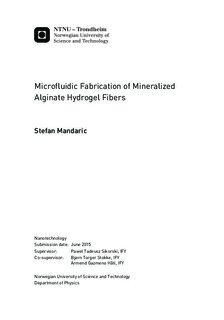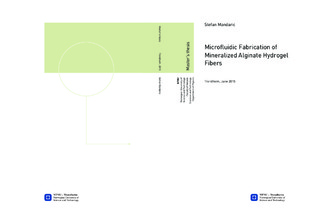| dc.contributor.advisor | Sikorski, Pawel Tadeusz | |
| dc.contributor.advisor | Stokke, Bjørn Torger | |
| dc.contributor.advisor | Håti, Armend Gazmeno | |
| dc.contributor.author | Mandaric, Stefan | |
| dc.date.accessioned | 2015-10-06T08:03:15Z | |
| dc.date.available | 2015-10-06T08:03:15Z | |
| dc.date.created | 2015-06-30 | |
| dc.date.issued | 2015 | |
| dc.identifier | ntnudaim:12921 | |
| dc.identifier.uri | http://hdl.handle.net/11250/2352107 | |
| dc.description.abstract | Alginates are a family of naturally occurring polysaccharides that form gels in the presence
of Ca2+-ions at physiological conditions. Calcium phosphate mineralized alginates have
previously been investigated as a synthetic extracellular matrix in bone tissue engineering.
The isotropic nature of hydrogels fails to mimic the directional structure observed at different lengths scales in bone tissue. A composite structure of calcium phosphate mineralized alginate fibers embedded in a matrix of unmineralized alginate gel has been suggested as a method for imitating the structure of bone tissue. The fabrication of mineralized alginate fibers for bone tissue engineering applications using microfluidic devices has been investigated in this work.
Fabrication of mineralized fibers was attempted using coaxial flow in microfluidic
channels. A glass capillary microfluidic device was investigated to generate a coaxial
flow of sodium alginate and phosphate ions surrounded by a flow of CaCl2. The device
was prone to clogging caused by buildup of alginate and minerals at the device surfaces.
A second microfluidic device was designed in an attempt to prevent clogging. A flow
of DI water was flown between the sodium alginate and CaCl2 to act as a buffer delaying the
onset of gelation until the flows cleared the device walls. Device geometries, flow rates
and viscosities of the solutions were investigated to find parameters resulting in stable
flow. Short lengths of calcium phosphate mineralized alginate fibers were successfully
fabricated. Precipitation of CaP minerals and alginate buildup along device walls was
decreased in the second device, but still resulted in device failure.
Mineralized fibers were shown to have a inhomogeneous structure with CaP minerals
concentrated around the perimeter. Calcium phosphate minerals were observed in SEM
micrographs as nano-sized sheets within the gel network. Mineralized fibers were found
to have a higher resistance to deformation compared to unmineralized.
Further process development is required for stable fabrication of mineralized alginate
fibers. A 3D microfluidic design has been proposed to further separate the sodium alginate
flow from device walls in an attempt to prevent buildup of gel and minerals along device
walls. In addition, an alternative mineralization process could be used where mineralization occurs outside the microchannels. | |
| dc.language | eng | |
| dc.publisher | NTNU | |
| dc.subject | Nanoteknologi, Bionanoteknologi | |
| dc.title | Microfluidic Fabrication of Mineralized Alginate Hydrogel Fibers | |
| dc.type | Master thesis | |
| dc.source.pagenumber | 101 | |

